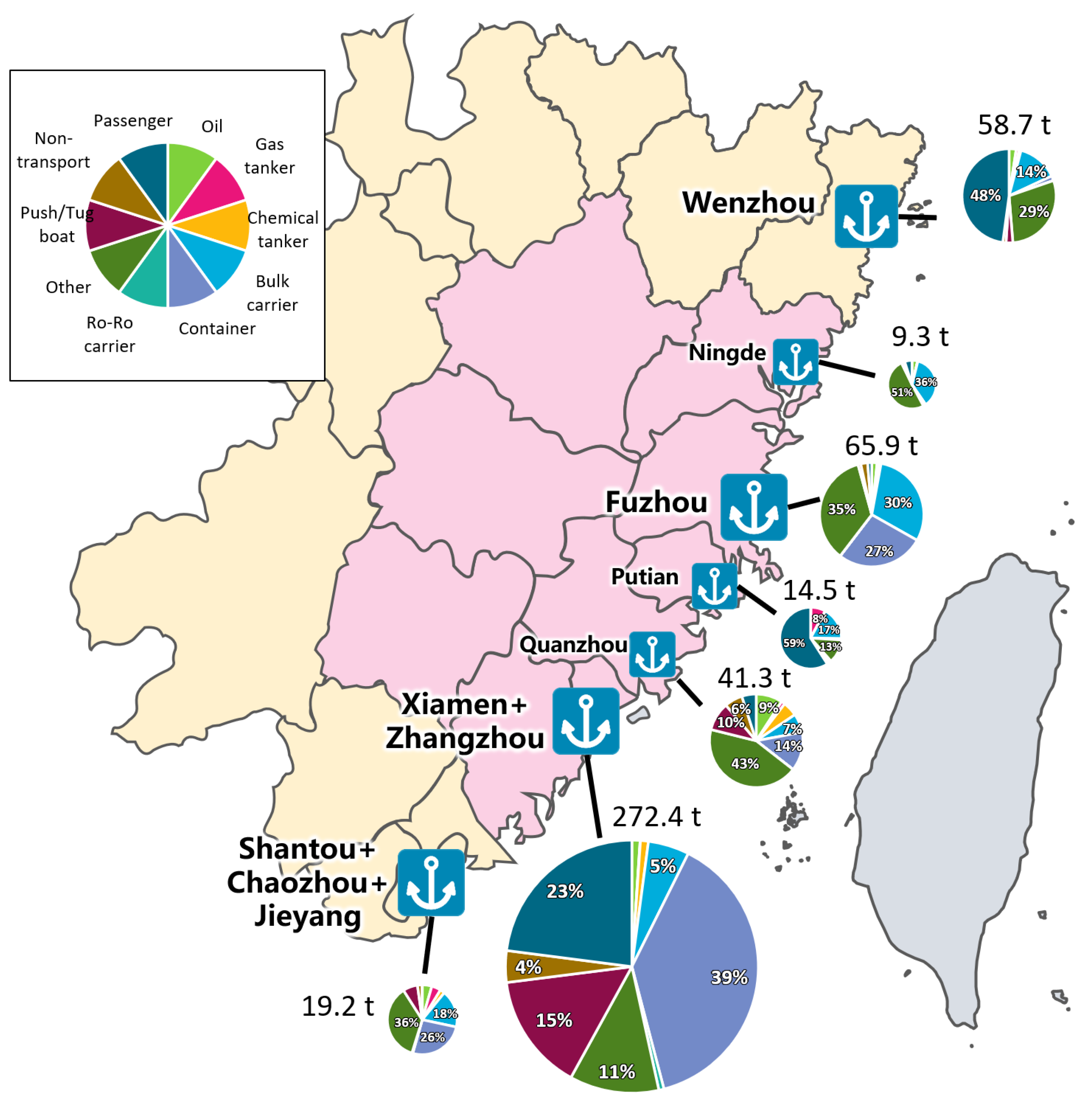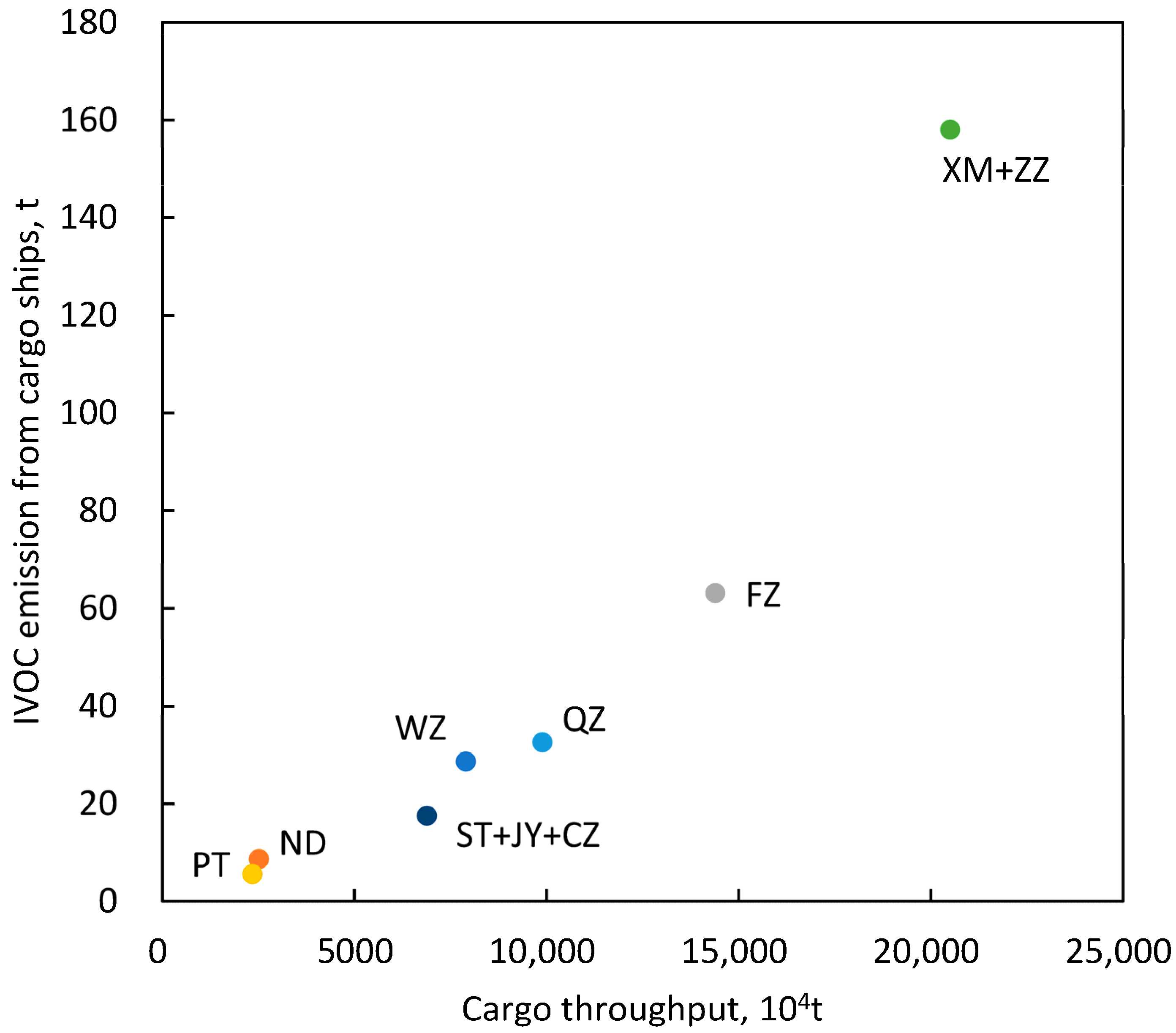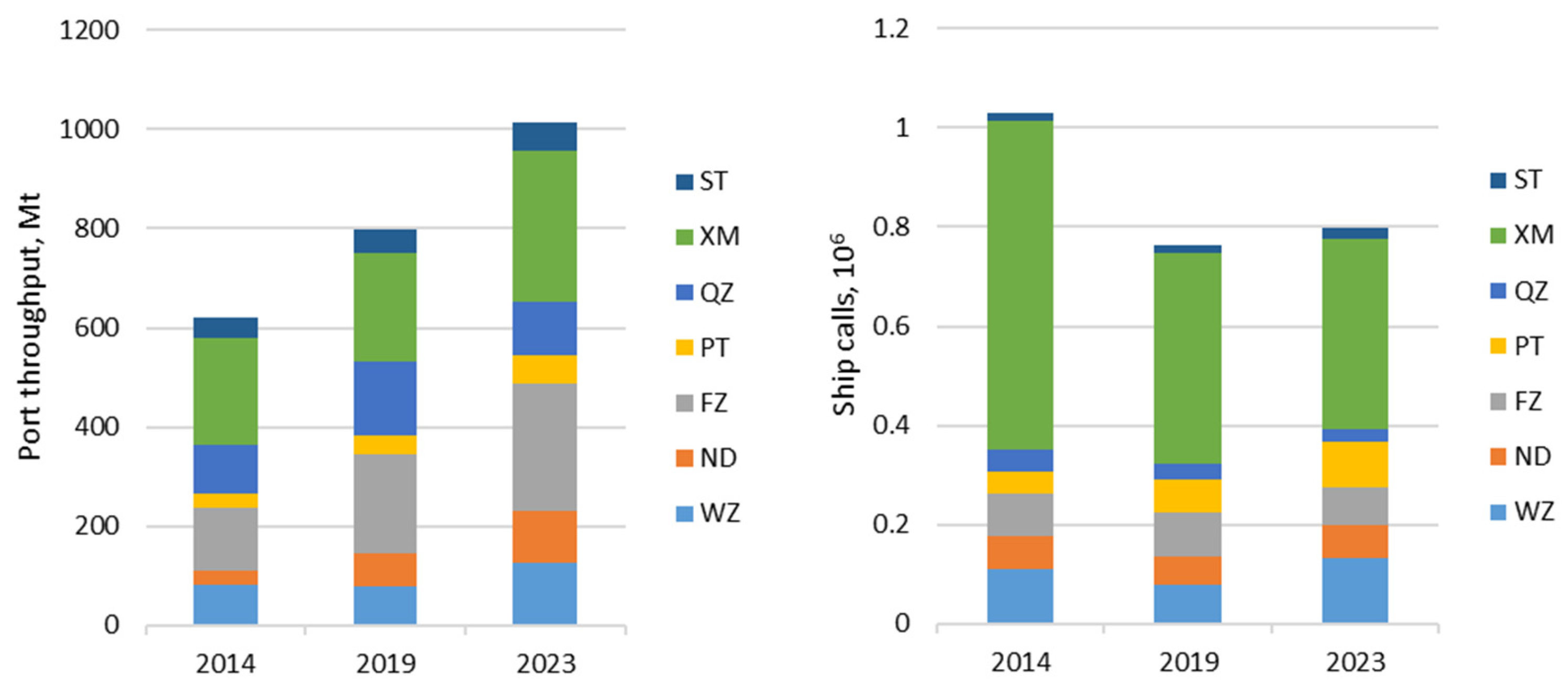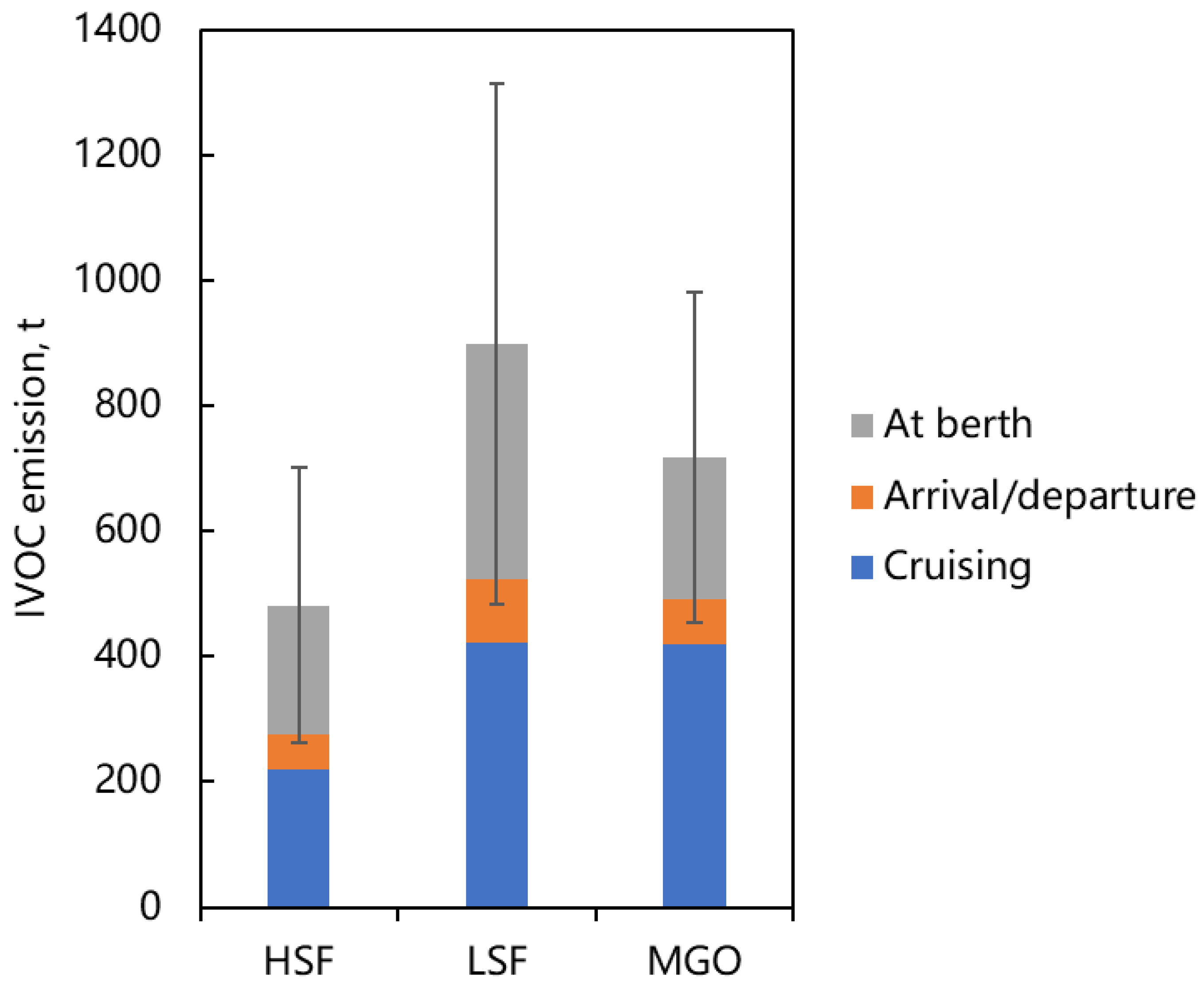Building the I/SVOC Emission Inventory for Ocean-Going Ships: A Case Study on the Southeast Coast of China
Abstract
1. Introduction
2. Materials and Methods
2.1. Emission Factors
2.2. Methodology for Establishing the Emission Inventory Based on Ship Calls
2.3. Key Parameters in the Case Study of the WCTS Region
| Parameter | Value | Data Source Reference | Uncertainty Estimation Method |
|---|---|---|---|
| Emission factors that are directly from literatures | See Table 1 | Huang et al. [21]; Liu et al. [22]; Zheng et al. [30] | A |
| Emission factors that are extrapolated | See Table 1 | Huang et al. [21]; Liu et al. [22] | B |
| Emission factors that are estimated from IVOC/OC | See Table 1 | OC data from Zhang et al. [29]; IVOC/OC from Huang et al. [21] | B |
| Ship calls | 1,622,224 in total (port, ship type and tonnage specific) | Maritime statistical data of the government | - |
| Berthing duration | 16–24.3 h (port specific) | Maritime statistical data of the government | C |
| Average rated power | See Chen et al. [5] | Chen et al. [5], which is estimated from Lloyd’s database and the China Classification Society database | C |
| Loading Factor | See Chen et al. [5] | Chen et al. [5], which is estimated from the combination of Lloyd’s database, the China Classification Society database, AIS data, and the Propeller Law. | D |
| Cruising speed | Cargo ships: 10 kn High-speed passenger vessels: 25 kn Other passenger vessels: 15 kn | Determined based on investigation and literatures | D |
| Maneuvering speed | 4 kn | Determined based on investigation and literatures | D |
| Duration of entering and exiting | 1 h | Determined based on investigation and literatures | D |
| Total sailing distance | 30–67 nm for cargo ships, 2 nm for passenger ships | Determined based on the distance between the port and the 12 nm territorial sea boundary, or on the average distance between major offshore islands and the mainland | - |
3. Results and Discussions
3.1. Total IVOC Emissions
3.2. IVOC Emission Compositions
3.3. The Impacts of Controlling Fuel Sulfur Content
3.4. Uncertainty Analysis
4. Conclusions
Author Contributions
Funding
Institutional Review Board Statement
Informed Consent Statement
Data Availability Statement
Conflicts of Interest
Abbreviations
| IVOC | Intermediate-volatility organic compounds |
| PM | Particulate matter |
| OA | Organic aerosol |
| SOA | Secondary organic aerosol |
| WCTS | The Economic Zone on the West Coast of the Taiwan Straits |
| ME | Main engine |
| AE | Auxiliary engine |
| HSFO | High sulfur content fuel oil |
| VLSFO | Very low sulfur content fuel |
| MGO | Maritime gas oil |
| CV | Coefficient of Variation |
References
- Eyring, V.; Isaksen, I.S.A.; Berntsen, T.; Collins, W.J.; Corbett, J.J.; Endresen, O.; Grainger, R.G.; Moldanova, J.; Schlager, H.; Stevenson, D.S. Transport impacts on atmosphere and climate: Shipping. Atmos. Environ. 2010, 44, 4735–4771. [Google Scholar] [CrossRef]
- Contini, D.; Merico, E. Recent Advances in Studying Air Quality and Health Effects of Shipping Emissions. Atmosphere 2021, 12, 92. [Google Scholar] [CrossRef]
- Lv, Z.; Liu, H.; Ying, Q.; Fu, M.; Meng, Z.; Wang, Y.; Wei, W.; Gong, H.; He, K. Impacts of shipping emissions on PM2.5 pollution in China. Atmos. Chem. Phys. 2018, 18, 15811–15824. [Google Scholar] [CrossRef]
- Liu, Z.; Lu, X.; Feng, J.; Fan, Q.; Zhang, Y.; Yang, X. Influence of Ship Emissions on Urban Air Quality: A Comprehensive Study Using Highly Time-Resolved Online Measurements and Numerical Simulation in Shanghai. Environ. Sci. Technol. 2016, 51, 202–211. [Google Scholar] [CrossRef] [PubMed]
- Chen, D.; Wang, X.; Li, Y.; Lang, J.; Zhou, Y.; Guo, X.; Zhao, Y. High-spatiotemporal-resolution ship emission inventory of China based on AIS data in 2014. Sci. Total Environ. 2017, 609, 776–787. [Google Scholar] [CrossRef] [PubMed]
- Mao, J.; Zhang, Y.; Yu, F.; Chen, J.; Sun, J.; Wang, S.; Zou, Z.; Zhou, J.; Yu, Q.; Ma, W.; et al. Simulating the impacts of ship emissions on coastal air quality: Importance of a high-resolution emission inventory relative to cruise- and land-based observations. Sci. Total Environ. 2020, 728, 138454. [Google Scholar] [CrossRef]
- Yi, W.; Wang, X.; He, T.; Liu, H.; Luo, Z.; Lv, Z.; He, K. The high-resolution global shipping emission inventory by the Shipping Emission Inventory Model (SEIM). Earth Syst. Sci. Data 2025, 17, 277–292. [Google Scholar] [CrossRef]
- Wang, S.; Xing, J.; Chatani, S.; Hao, J.; Klimont, Z.; Cofala, J.; Amann, M. Verification of anthropogenic emissions of China by satellite and ground observations. Atmos. Environ. 2011, 45, 6347–6358. [Google Scholar] [CrossRef]
- Zhang, Q.; Streets, D.G.; Carmichael, G.R.; He, K.B.; Huo, H.; Kannari, A.; Klimont, Z.; Park, I.S.; Reddy, S.; Fu, J.S.; et al. Asian emissions in 2006 for the NASA INTEX-B mission. Atmos. Chem. Phys. 2009, 9, 5131–5153. [Google Scholar] [CrossRef]
- Robinson, A.L.; Donahue, N.M.; Shrivastava, M.K.; Weitkamp, E.A.; Sage, A.M.; Grieshop, A.P.; Lane, T.E.; Pierce, J.R.; Pandis, S.N. Rethinking organic aerosols: Semivolatile emissions and photochemical aging. Science 2007, 315, 1259–1262. [Google Scholar] [CrossRef]
- Zhao, Y.L.; Hennigan, C.J.; May, A.A.; Tkacik, D.S.; de Gouw, J.A.; Gilman, J.B.; Kuster, W.C.; Borbon, A.; Robinson, A.L. Intermediate-Volatility Organic Compounds: A Large Source of Secondary Organic Aerosol. Environ. Sci. Technol. 2014, 48, 13743–13750. [Google Scholar] [CrossRef]
- Liu, H.; Man, H.; Cui, H.; Wang, Y.; Deng, F.; Wang, Y.; Yang, X.; Xiao, Q.; Zhang, Q.; Ding, Y.; et al. An updated emission inventory of vehicular VOCs and IVOCs in China. Atmos. Chem. Phys. 2017, 17, 12709–12724. [Google Scholar] [CrossRef]
- Wu, L.; Ling, Z.; Liu, H.; Shao, M.; Lu, S.; Wu, L.; Wang, X. A gridded emission inventory of semi-volatile and intermediate volatility organic compounds in China. Sci. Total Environ. 2021, 761, 143295. [Google Scholar] [CrossRef] [PubMed]
- Wu, L.Q.; Wang, X.M.; Lu, S.H.; Shao, M.; Ling, Z.H. Emission inventory of semi-volatile and intermediate-volatility organic compounds and their effects on secondary organic aerosol over the Pearl River Delta region. Atmos. Chem. Phys. 2019, 19, 8141–8161. [Google Scholar] [CrossRef]
- Zhang, Z.; Man, H.; Zhao, J.; Huang, W.; Huang, C.; Jing, S.; Luo, Z.; Zhao, X.; Chen, D.; He, K.; et al. VOC and IVOC emission features and inventory of motorcycles in China. J. Hazard. Mater. 2024, 469, 133928. [Google Scholar] [CrossRef]
- Zhu, Y.; Wang, Q.; Huang, L.; Yin, S.; Li, L.; Wang, Y. Emission Inventory of Intermediate Volatility Organic Compounds (IVOCs) from Biomass Burning in the Yangtze River Delta During 2010–2018. Huanjing Kexue 2020, 41, 3511–3517. [Google Scholar]
- Zhao, J.; Qi, L.; Lv, Z.; Wang, X.; Deng, F.; Zhang, Z.; Luo, Z.; Bie, P.; He, K.; Liu, H. An updated comprehensive IVOC emission inventory for mobile sources in China. Sci. Total Environ. 2022, 851, 158312. [Google Scholar] [CrossRef]
- Lyu, X.P.; Guo, H.; Cheng, H.R.; Wang, X.M.; Ding, X.; Lu, H.X.; Yao, D.W.; Xu, C. Observation of SOA tracers at a mountainous site in Hong Kong: Chemical characteristics, origins and implication on particle growth. Sci. Total Environ. 2017, 605–606, 180–189. [Google Scholar] [CrossRef]
- Tong, M.; Zhang, Y.; Zhang, H.; Chen, D.; Pei, C.; Guo, H.; Song, W.; Yang, X.; Wang, X. Contribution of Ship Emission to Volatile Organic Compounds Based on One-Year Monitoring at a Coastal Site in the Pearl River Delta Region. J. Geophys. Res. Atmos. 2024, 129, e2023JD039999. [Google Scholar] [CrossRef]
- Cui, M.; Xu, Y.; Liu, Z.; Zhang, Y.; Zhang, F.; Yan, C.; Chen, Y. Characteristics of intermediate volatility organic compounds emitted from inland vessels with different influential factors and implication of reduction emissions. Sci. Total Environ. 2023, 904, 166868. [Google Scholar] [CrossRef]
- Huang, C.; Hu, Q.; Wang, H.; Qiao, L.; Jing, S.a.; Wang, H.; Zhou, M.; Zhu, S.; Ma, Y.; Lou, S.; et al. Emission factors of particulate and gaseous compounds from a large cargo vessel operated under real-world conditions. Environ. Pollut. 2018, 242, 667–674. [Google Scholar] [CrossRef] [PubMed]
- Liu, Z.; Chen, Y.; Zhang, Y.; Zhang, F.; Feng, Y.; Zheng, M.; Li, Q.; Chen, J. Emission Characteristics and Formation Pathways of Intermediate Volatile Organic Compounds from Ocean-Going Vessels: Comparison of Engine Conditions and Fuel Types. Environ. Sci. Technol. 2022, 56, 12917–12925. [Google Scholar] [CrossRef] [PubMed]
- Lou, H.J.; Hao, Y.J.; Zhang, W.W.; Su, P.H.; Zhang, F.; Chen, Y.J.; Feng, D.L.; Li, Y.F. Emission of intermediate volatility organic compounds from a ship main engine burning heavy fuel oil. J. Environ. Sci. 2019, 84, 197–204. [Google Scholar] [CrossRef] [PubMed]
- Su, P.; Hao, Y.; Qian, Z.; Zhang, W.; Chen, J.; Zhang, F.; Yin, F.; Feng, D.; Chen, Y.; Li, Y. Emissions of intermediate volatility organic compound from waste cooking oil biodiesel and marine gas oil on a ship auxiliary engine. J. Environ. Sci. 2020, 91, 262–270. [Google Scholar] [CrossRef]
- The People’s Government of Fujian Province. The ‘14th Five-Year’ Special Plan for the Construction of Ecological Province in Fujian Province. 2022. Available online: https://www.fujian.gov.cn/zwgk/ghjh/ghxx/202204/t20220427_5900528.htm (accessed on 13 September 2025).
- Lin, Z.; Fan, X.; Chen, G.; Hong, Y.; Li, M.; Xu, L.; Hu, B.; Yang, C.; Chen, Y.; Shao, Z.; et al. Sources appointment and health risks of PM2.5-bound trace elements in a coastal city of southeastern China. J. Environ. Sci. 2024, 138, 561–571. [Google Scholar] [CrossRef]
- Yu, G.; Zhang, Y.; Wang, Q.; Han, Z.; Jiang, S.; Yang, F.; Yang, X.; Huang, C. Changes in the impacts of ship emissions on PM2.5 and its components in China under the staged fuel oil policies. EGUsphere 2025, 2025, 9497–9518. [Google Scholar] [CrossRef]
- IMO. 2019 Guidelines for Consistent Implementation of the 0.50% Sulphur Limit Under Marpol Annex VI, MEPC 74/18/Add.1 Annex 14; IMO: London, UK, 2019; Available online: https://wwwcdn.imo.org/localresources/en/KnowledgeCentre/IndexofIMOResolutions/MEPCDocuments/MEPC.320%2874%29.pdf (accessed on 7 August 2025).
- Zhang, F.; Chen, Y.; Tian, C.; Lou, D.; Li, J.; Zhang, G.; Matthias, V. Emission factors for gaseous and particulate pollutants from offshore diesel engine vessels in China. Atmos. Chem. Phys. 2016, 16, 6319–6334. [Google Scholar] [CrossRef]
- Zheng, H.; Chang, X.; Wang, S.; Li, S.; Yin, D.; Zhao, B.; Huang, G.; Huang, L.; Jiang, Y.; Dong, Z.; et al. Trends of Full-Volatility Organic Emissions in China from 2005 to 2019 and Their Organic Aerosol Formation Potentials. Environ. Sci. Technol. Lett. 2023, 10, 137–144. [Google Scholar] [CrossRef]
- Li, Y.; Zhang, Y.; Cheng, J.; Zheng, C.; Li, M.; Xu, H.; Wang, R.; Chen, D.; Wang, X.; Fu, X.; et al. Comparative Analysis, Use Recommendations, and Application Cases of Methods for Develop Ship Emission Inventories. Atmosphere 2022, 13, 1224. [Google Scholar] [CrossRef]
- Fu, M.; Liu, H.; Jin, X.; He, K. National- to port-level inventories of shipping emissions in China. Environ. Res. Lett. 2017, 12, 114024. [Google Scholar] [CrossRef]
- Ng, S.K.W.; Loh, C.; Lin, C.; Booth, V.; Chan, J.W.M.; Yip, A.C.K.; Li, Y.; Lau, A.K.H. Policy change driven by an AIS-assisted marine emission inventory in Hong Kong and the Pearl River Delta. Atmos. Environ. 2013, 76, 102–112. [Google Scholar] [CrossRef]
- Li, N. Quantitative Uncertainty Analysis and Verification of Emission Inventory in Guangdong Province, 2012. Master’s Thesis, South China University of Technology, Guangzhou, China, 2017. [Google Scholar]
- Streets, D.G.; Bond, T.C.; Carmichael, G.R.; Fernandes, S.D.; Fu, Q.; He, D.; Klimont, Z.; Nelson, S.M.; Tsai, N.Y.; Wang, M.Q.; et al. An inventory of gaseous and primary aerosol emissions in Asia in the year 2000. J. Geophys. Res.-Atmos. 2003, 108, 8809. [Google Scholar] [CrossRef]
- Wei, W. Study on Current and Future Anthropogenic Emissions of Volatile Organic Compounds in China. Ph.D. Thesis, Tsinghua University, Beijing, China, 2009. [Google Scholar]
- Ministry of Transport of the People’s Republic of China. National Coastal Ports Layout Plan. 2006. Available online: https://xxgk.mot.gov.cn/2020/jigou/zhghs/202006/t20200630_3320031.html (accessed on 13 September 2025).
- Chen, M. Implement Research of Marine Low Sulphur Fuel Oil. Open J. Transp. Technol. 2021, 10, 154–163. [Google Scholar] [CrossRef]
- Ershov, M.A.; Savelenko, V.D.; Makhmudova, A.E.; Rekhletskaya, E.S.; Makhova, U.A.; Kapustin, V.M.; Mukhina, D.Y.; Abdellatief, T.M.M. Technological Potential Analysis and Vacant Technology Forecasting in Properties and Composition of Low-Sulfur Marine Fuel Oil (VLSFO and ULSFO) Bunkered in Key World Ports. J. Mar. Sci. Eng. 2022, 10, 1828. [Google Scholar] [CrossRef]
- Xiao, B.; Zhang, F.; Liu, Z.; Zhang, Y.; Li, R.; Wu, C.; Wan, X.; Wang, Y.; Chen, Y.; Han, Y.; et al. Enhanced emission of intermediate-volatility/semi-volatile organic matter in gas and particle phases from ship exhausts with low-sulfur fuels. Atmos. Chem. Phys. 2025, 25, 7053–7069. [Google Scholar] [CrossRef]
- Chen, Y.; Yang, C.; Xu, L.; Chen, J.; Zhang, Y.; Shi, J.; Fan, X.; Zheng, R.; Hong, Y.; Li, M. Chemical composition of NR-PM1 in a coastal city of Southeast China: Temporal variations and formation pathways. Atmos. Environ. 2022, 285, 119243. [Google Scholar] [CrossRef]
- Lack, D.A.; Cappa, C.D.; Langridge, J.; Bahreini, R.; Buffaloe, G.; Brock, C.; Cerully, K.; Coffman, D.; Hayden, K.; Holloway, J.; et al. Impact of Fuel Quality Regulation and Speed Reductions on Shipping Emissions: Implications for Climate and Air Quality. Environ. Sci. Technol. 2011, 45, 9052–9060. [Google Scholar] [CrossRef]
- U.S and Canada Proposal to Designate an Emission Control Area for Nitrogen Oxides, Sulphur Oxides and Particulate Matter; MEPC 59/6/5; IMO: London, UK, 2009. Available online: https://www.epa.gov/sites/default/files/2018-05/documents/mepc59-6-5.pdf (accessed on 7 August 2025).
- Viana, M.; Fann, N.; Tobías, A.; Querol, X.; Rojas-Rueda, D.; Plaza, A.; Aynos, G.; Conde, J.A.; Fernández, L.; Fernández, C. Environmental and Health Benefits from Designating the Marmara Sea and the Turkish Straits as an Emission Control Area (ECA). Environ. Sci. Technol. 2015, 49, 3304–3313. [Google Scholar] [CrossRef]




| Ship Type | Engine | Fuel (Sulfur Content) | Operation Mode | IVOC EF (mg/kWh) |
|---|---|---|---|---|
| Bulk carrier | Main engine | HSFO (>0.5%) | Cruising | 151.6 |
| Maneuvering | 225.1 | |||
| VLSFO (≤0.5% and >0.1%) | Cruising | 325.2 | ||
| Maneuvering | 439.1 | |||
| MGO (≤0.1%) | Cruising | 402.3 | ||
| Maneuvering | 543.1 *a | |||
| Auxiliary engine | HSFO (>0.5%) | All | 328.8 *d | |
| VLSFO (≤0.5% and >0.1%) | All | 641.4 | ||
| MGO (≤0.1%) | All | 367.4 | ||
| Boiler | All | All | 5.24 | |
| Oil tanker | Main engine | HSFO (>0.5%) | Cruising | 94.6 *c |
| Maneuvering | 140.4 *c | |||
| VLSFO (≤0.5% and >0.1%) | Cruising | 202.9 | ||
| Maneuvering | 274.0 *b | |||
| MGO (≤0.1%) | Cruising | 212.8 | ||
| Maneuvering | 287.3 *b | |||
| Auxiliary engine | HSFO (>0.5%) | All | 281.0 *c | |
| VLSFO (≤0.5% and >0.1%) | All | 548.1 *c | ||
| MGO (≤0.1%) | All | 219.4 | ||
| Boiler | All | All | 5.24 | |
| Other cargo vessels and tug boat | Main engine | HSFO (>0.5%) | Cruising | 151.6 |
| Maneuvering | 225.1 | |||
| VLSFO (≤0.5% and >0.1%) | Cruising | 325.2 | ||
| Maneuvering | 439.1 | |||
| MGO (≤0.1%) | Cruising | 402.3 | ||
| Maneuvering | 543.1 *a | |||
| Auxiliary engine | HSFO (>0.5%) | All | 328.8 *d | |
| VLSFO (≤0.5% and >0.1%) | All | 641.4 | ||
| MGO (≤0.1%) | All | 367.4 | ||
| Boiler | All | All | 5.24 | |
| Passenger ships | Main engine | HSFO (>0.5%) | Cruising | 106.2 *c |
| Maneuvering | 122.3 *b | |||
| VLSFO (≤0.5% and >0.1%) | Cruising | 207.1 | ||
| Maneuvering | 214.7 *b | |||
| MGO (≤0.1%) | Cruising | 219.4 | ||
| Maneuvering | 227.5 *b | |||
| Auxiliary engine | HSFO (>0.5%) | All | 328.8 *d | |
| VLSFO (≤0.5% and >0.1%) | All | 641.4 | ||
| MGO (≤0.1%) | All | 367.4 | ||
| Boiler | All | All | 5.24 | |
| Non-transport ships | Main engine | MGO (≤0.1%) | Cruising | 59.2 *e |
| Maneuvering | 28.2 *e |
| City | Wenzhou | Ningde | Fuzhou | Putian | Quanzhou | Xiamen+ Zhangzhou | Shantou+ Chaozhou+ Jieyang |
|---|---|---|---|---|---|---|---|
| On road vehicles | 1187.9 | 376.5 | 1661.8 | 402.7 | 1579.2 | 2062.5 | 747.1 |
| Off-road transportation | 433.0 | 144.5 | 426.0 | 127.5 | 522.7 | 537.8 | 257.3 |
| Port ships | 58.8 | 9.3 | 65.9 | 14.5 | 41.3 | 272.4 | 19.2 |
| Cargo Ship (314.0 t in Total) | Passenger Ship | Non-Transport Ship | Push/Tug Boat | ||||||
|---|---|---|---|---|---|---|---|---|---|
| Oil Tanker | Gas Tanker | Chemical Tanker | Bulk Carrier | Container | Ro-Ro Carrier | Other | |||
| 10.4 | 3.5 | 6.2 | 54.4 | 134.8 | 1.9 | 102.9 | 102.6 | 16.3 | 48.5 |
| <100 Gt | 100~500 Gt | 500~1000 Gt | 1000~2000 Gt | 3000~10,000 Gt | 10,000~50,000 Gt | >50,000 Gt | |
|---|---|---|---|---|---|---|---|
| IVOC emission, t | 0.1 | 18.1 | 2.5 | 53.4 | 63.0 | 95.7 | 81.2 |
| % | 0.0% | 5.7% | 0.8% | 17.0% | 20.0% | 30.5% | 25.9% |
| Ship calls | 2620 | 95,008 | 5184 | 69,018 | 36,673 | 23,636 | 8917 |
| % | 1.1% | 39.4% | 2.2% | 28.6% | 15.2% | 9.8% | 3.7% |
| Cruising | Arrival/Departure | At Berth | |
|---|---|---|---|
| IVOC emission, t | 220.4 | 54.7 | 206.3 |
| % | 45.8% | 11.4% | 42.9% |
Disclaimer/Publisher’s Note: The statements, opinions and data contained in all publications are solely those of the individual author(s) and contributor(s) and not of MDPI and/or the editor(s). MDPI and/or the editor(s) disclaim responsibility for any injury to people or property resulting from any ideas, methods, instructions or products referred to in the content. |
© 2025 by the authors. Licensee MDPI, Basel, Switzerland. This article is an open access article distributed under the terms and conditions of the Creative Commons Attribution (CC BY) license (https://creativecommons.org/licenses/by/4.0/).
Share and Cite
Chang, X.; Li, Y.; Zhang, Y.; Li, M.; Yang, X.; Huang, Q.; Song, Y.; Wu, R.; Liu, J.; Xing, Y. Building the I/SVOC Emission Inventory for Ocean-Going Ships: A Case Study on the Southeast Coast of China. Sustainability 2025, 17, 8310. https://doi.org/10.3390/su17188310
Chang X, Li Y, Zhang Y, Li M, Yang X, Huang Q, Song Y, Wu R, Liu J, Xing Y. Building the I/SVOC Emission Inventory for Ocean-Going Ships: A Case Study on the Southeast Coast of China. Sustainability. 2025; 17(18):8310. https://doi.org/10.3390/su17188310
Chicago/Turabian StyleChang, Xing, Yue Li, Yonglin Zhang, Mingjun Li, Xiaowen Yang, Quansheng Huang, Yuanyuan Song, Rui Wu, Jie Liu, and Youkai Xing. 2025. "Building the I/SVOC Emission Inventory for Ocean-Going Ships: A Case Study on the Southeast Coast of China" Sustainability 17, no. 18: 8310. https://doi.org/10.3390/su17188310
APA StyleChang, X., Li, Y., Zhang, Y., Li, M., Yang, X., Huang, Q., Song, Y., Wu, R., Liu, J., & Xing, Y. (2025). Building the I/SVOC Emission Inventory for Ocean-Going Ships: A Case Study on the Southeast Coast of China. Sustainability, 17(18), 8310. https://doi.org/10.3390/su17188310






